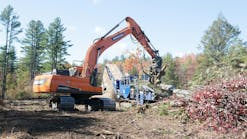The vehicles and construction equipment were caked in sludge and dust. The soldiers of 617th Engineer Company “Trailblazers” were covered in dirt with sweat dripping from their faces as they returned each evening from their five-day mission repairing a vital access road in the Khost Province, Afghanistan.
The soldiers, however, did not let the situation hinder the completion of their mission. The access road was successfully completed 10 days ahead of schedule.
The combination of a sharp bend in the road and a large storm with heavy August rains had created a situation that washed out a portion of a main supply route used by both coalition forces and the local populace. The washout of this road meant that the delivery of supplies to the local forward operating base, the retrograde of US forces and materiel, and the daily use by the local populace was extremely limited, if not impossible.
The 617th did not let the situation hinder the completion of their mission.
At the time of the storm, the 617th was conducting deconstruction operations at a nearby forward operating base as part of the 43rd Sustainment Brigade, US Central Command Materiel Recovery Element’s retrograde operations throughout Regional Command-East, Afghanistan.
Up until this point of the deployment, the 617th Engineer Company had conducted mostly deconstruction operations and very few construction operations. The company’s operations have focused on deconstructing wood and concrete buildings, tearing down and replacing protective barriers, and removing various types of expeditionary structures. Therefore, for many of the younger soldiers, the opportunity to reconstruct a road was a welcome mission.
“The mission was new to the majority of the soldiers,” said 1st Lt. Paul Jackson, platoon leader for the 2nd platoon. “A few of the noncommissioned officers had experience with road repair and lent their experience to the planning of the repair. This was the first road repair mission for the company on this deployment.”
Nonetheless, the inexperience level did not deter or frustrate these trailblazing soldiers. “Our platoon was given the tough, demanding mission that had to be completed for other missions to be completed,” said Staff Sgt. Benjamin Davis, a squad leader in the 2nd platoon. “The platoon’s pride, experience, and determination got the mission completed to a high standard.”
In five days, the Trailblazer Soldiers repaired 180 feet of road by laying 900 feet of HESCO barriers in a grid to create a stable base for the road using D7G dozers, hydraulic excavators, 5-yard scoop loaders, and skid-steer loaders. Approximately 3,000 cubic yards of dirt were used to fill the washout and create a berm in front of the road. They also diverted 300 feet of the creek that runs beside the road in order to prevent future erosion.
All in all, the amount of work these soldiers accomplished in five days was quite astounding, according to Sgt. 1st Class Pedro Armijo, platoon sergeant of the 2nd platoon. “It was a great opportunity to show our capability as engineers by opening a major supply route for Regional Command-East and aiding the local populace,” said Armijo.
The soldiers of the 2nd platoon had help from units stationed at the same forward operating base. Alpha Company, 4th Brigade Special Troops Battalion, 4th Brigade Combat Team, 101st Airborne Division provided daily route clearance, while Alpha Troop, 1st Squadron, 61st Cavalry, provided additional security on the job site.
With every new mission comes new lessons learned, and working with companies from other battalions in a combined arms environment was lesson No. 1, according to Jackson. “Since this was the platoon’s first construction mission outside the wire, the mission taught us how to interact efficiently with other units, particularly for security,” said Jackson.
Other lessons learned stem from the engineering and technical aspects of the operation. “Drainage is important, especially when working in a creek bed,” said Jackson. “Because the water naturally flowed next to the road at the point of the washout, we constantly had to improve our drainage system to keep the job site dry.”
Overall, the mission had positive results with lasting lessons. “The platoon grew closer as we worked together on the project,” said Jackson. “The mission allowed the soldiers to feel accomplished as they saw the project go from planning and preparation to completion, with the end result affecting coalition forces and the Afghan populace. Most importantly, the soldiers learned the importance of the platoon working together as a single unit to efficiently complete a project.”




